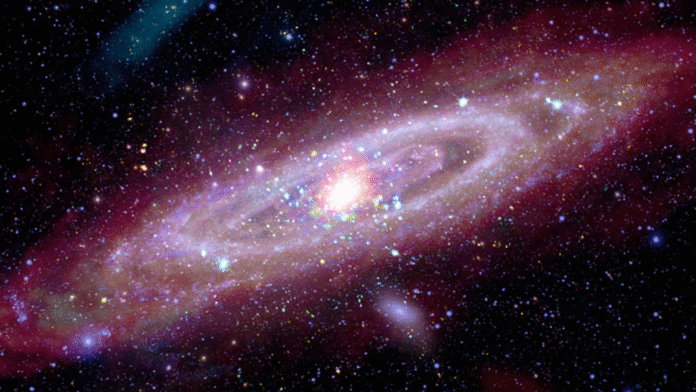The galaxy adjacent to the Milky Way, Andromeda, has never appeared as breathtaking as it does in a new image captured by NASA’s Chandra X-ray space telescope.
This image of the galaxy, also referred to as Messier 31 (M31), was produced with the help of various space telescopes and ground-based instruments, including the European Space Agency (ESA) XMM-Newton mission, NASA’s retired telescopes GALEX and Spitzer, as well as the Infrared Astronomy Satellite, COBE, Planck, and Herschel, complemented by radio data from the Westerbork Synthesis Radio Telescope.
All these instruments observed Andromeda in diverse wavelengths of light across the electromagnetic spectrum, enabling astronomers to compile this data into a remarkable and detailed image. This image serves as an homage to astronomer Vera C. Rubin, who played a crucial role in the discovery of dark matter through her observations of Andromeda.
(Image credit: X-ray: NASA/CXO/UMass/Z. Li & Q.D. Wang, ESA/XMM-Newton; Infrared: NASA/JPL-Caltech/WISE, Spitzer, NASA/JPL-Caltech/K. Gordon (U. Az), ESA/Herschel, ESA/Planck, NASA/IRAS, NASA/COBE; Radio: NSF/GBT/WSRT/IRAM/C. Clark (STScI); Ultraviolet: NASA/JPL-Caltech/GALEX; Optical: Andromeda, Unexpected © Marcel Drechsler, Xavier Strottner, Yann Sainty & J. Sahner, T. Kottary. Composite image processing: L. Frattare, K. Arcand, J.Major)
As the nearest large galaxy to the Milky Way, located approximately 2.5 million light-years away, Andromeda has been indispensable in enabling astronomers to study aspects of galaxies that are not visible from our own galaxy. For instance, while we cannot observe the spiral arms of the Milky Way, we can see the spiral arms of Andromeda.
Every wavelength of light that was combined to create this remarkable new image of Andromeda offers astronomers unique insights about our neighboring galaxy.
For instance, the X-ray data from Chandra has uncovered the high-energy radiation emanating from around Andromeda’s central supermassive black hole, known as M31*.

(Image credit: X-ray: NASA/CXO/UMass/Z. Li & Q.D. Wang, ESA/XMM-Newton; Infrared: NASA/JPL-Caltech/WISE, Spitzer, NASA/JPL-Caltech/K. Gordon (U. Az), ESA/Herschel, ESA/Planck, NASA/IRAS, NASA/COBE; Radio: NSF/GBT/WSRT/IRAM/C. Clark (STScI); Ultraviolet: NASA/JPL-Caltech/GALEX; Optical: Andromeda, Unexpected © Marcel Drechsler, Xavier Strottner, Yann Sainty & J. Sahner, T. Kottary. Composite image processing: L. Frattare, K. Arcand, J.Major)
M31* is significantly larger than the supermassive black hole at the center of the Milky Way, known as Sagittarius A* (Sgr A*). While our own supermassive black hole has a mass 4.3 million times that of the sun, M31* surpasses it with a mass 100 million times that of the sun. M31* is also distinguished by its occasional flares, one of which was detected in X-rays back in 2013, whereas Sgr A* is a much “quieter” black hole.
What connects Andromeda and Rubin?
Andromeda was selected as a tribute to Rubin because this neighboring galaxy played a pivotal role in her discovery of an elusive element of the universe, commonly referred to as dark matter.
In the 1960s, Rubin and her colleagues meticulously measured the rotation of Andromeda. They discovered that the speed at which the galaxy’s spiral arms rotated indicated the presence of a vast halo of an unknown and invisible type of matter surrounding it.
The mass of this matter exerted gravitational force crucial for keeping Andromeda intact, preventing it from dispersing due to its rotational velocity. The gravity of its visible components alone was insufficient to maintain the galaxy’s cohesion.
Since then, astronomers have identified similar halos of what is now called dark matter surrounding all large galaxies. This has led to the conclusion that the matter comprising everything we can observe—stars, planets, moons, our bodies, and even next door’s cat—accounts for merely 15% of the universe’s “stuff,” while dark matter constitutes the remaining 85%. This discovery has also initiated the quest for particles beyond the standard model of particle physics that could make up dark matter.
Clearly, Rubin’s contributions marked a pivotal moment in astronomy and represent one of science’s most significant breakthroughs, fundamentally altering our understanding of the universe.
June 2025 has seen a significant recognition of Rubin’s extensive contributions to astronomy and her enduring legacy. Besides this tribute image, the Vera C. Rubin Observatory has released its first cosmic images as it prepares for a ten-year observational program of the southern sky called the Legacy Survey of Space and Time (LSST).
Furthermore, in acknowledgment of Rubin’s monumental impact on our comprehension of the universe, the United States Mint has recently released a quarter featuring Rubin as part of its American Women Quarters Program, making her the first astronomer to be honored in the series.






